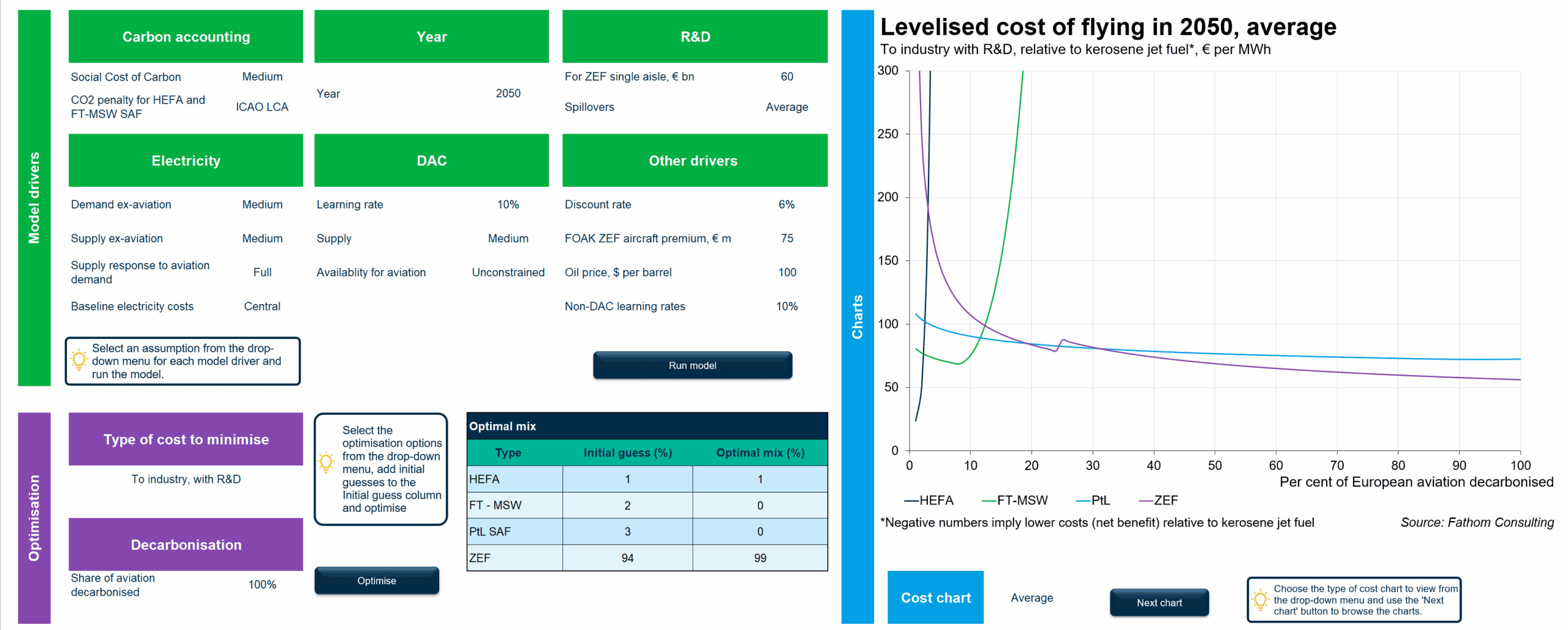Fathom’s Aviation Decarbonisation Model
How does the cost of hydrogen-powered, zero-emission flight compare with aircraft powered by fuel made from used cooking oil? How does that calculus change over time, as an increasing percentage of planes adopt these new decarbonisation technologies? And how sensitive are these results to changes in electricity supply and demand, fluctuating oil prices and varying rates of technological progress?
Fathom’s Aviation Decarbonisation Model shows how the costs of different decarbonisation technologies move in different scenarios. Available to clients via an interactive dashboard, it allows users to alter the settings on up to 17 inputs to create scenarios, thus gaining insight into the drivers and the relative merits of each of these technologies. The model calculates the optimal decarbonisation mix for each scenario, from the points of view of both industry and society. It is a flexible tool that can be used in a variety of ways by policymakers, businesses and other stakeholders.

How the model works
The decarbonisation methods covered are: hydrogen-powered, zero-emission flight (ZEF); synthetic power-to-liquid (PtL) fuels; and sustainable aviation fuels made using hydroprocessed esters and fatty acids (HEFA), or by the Fischer-Tropsch technique with waste (FT, waste). Uniquely, the model expresses the costs of each of these methods in levelised terms, making it possible to draw direct comparisons [see box]. More than 140 parameters underpin the model.
Understanding the output
The model output shows the levelised cost of each of the decarbonisation options over kerosene in euros per MWh. The output is accessed via six charts with the information shown on those charts illustrated in the table below.
Fathom's Aviation Decarbonisation Model
| Information available | |||
|---|---|---|---|
| To industry, including R&D | To industry, excluding R&D | To society, including externalities | |
| Marginal levelised cost | |||
| Average levelised cost | |||
Each chart has four curves, each representing the relative cost of a specific aviation decarbonisation technology at a given level of decarbonisation at a particular point in time. The shape of the curve illustrates how the cost of the technology changes at different levels of decarbonisation (the horizontal axis shows the level of decarbonisation in the chosen year). This information can be used to identify the decarbonisation mix in that scenario which lowers the overall cost of decarbonising for any given level of overall decarbonisation.
Controlling the input
The costs of different forms of SAFs and ZEF, and the ability to scale them, will depend on choices made by policymakers and the private sector. Nobody can say exactly how those will evolve, although Fathom’s central case is preloaded into the model. The model shows how the costs and benefits change as the user makes changes to the 17 model drivers, which are listed below:
Fathom's Aviation Decarbonisation Model drivers
| Year | Social cost of carbon | CO2 penalty for HEFA and FT-MSW SAF |
| R&D needed for ZEF single aisle aircraft | R&D spillovers | Electricity demand (excluding aviation) |
| Electricity supply (excluding aviation) | Supply response to aviation’s electricity demand | Baseline electricity costs |
| DAC technology progress | DAC supply | DAC availability for aviation |
| Discount rate | First-of-a-kind ZEF aircraft premium | Oil price |
| Non-DAC technological progress | Share of aviation decarbonised |
Who uses this model:
Policymakers can use the information to better understand how to lower costs and maximise the benefits to the industry and society. Understanding how the optimal decarbonisation mix differs when considered from the perspectives of industry and society is key, and the model lets users do that. Businesses, ranging from airports and airlines to energy providers, can use the model to better understand the drivers of different decarbonisation options, helping them to forecast demand, manage risk, take advantage of opportunities and make plans.
Different subscription options are available. Fathom can work with clients to understand how the model can be used to answer questions, such as those answered in our work sponsored by the European Climate Foundation.
Subscription services
Fathom offers three subscription services. For pricing and to discuss usability, please get in touch.